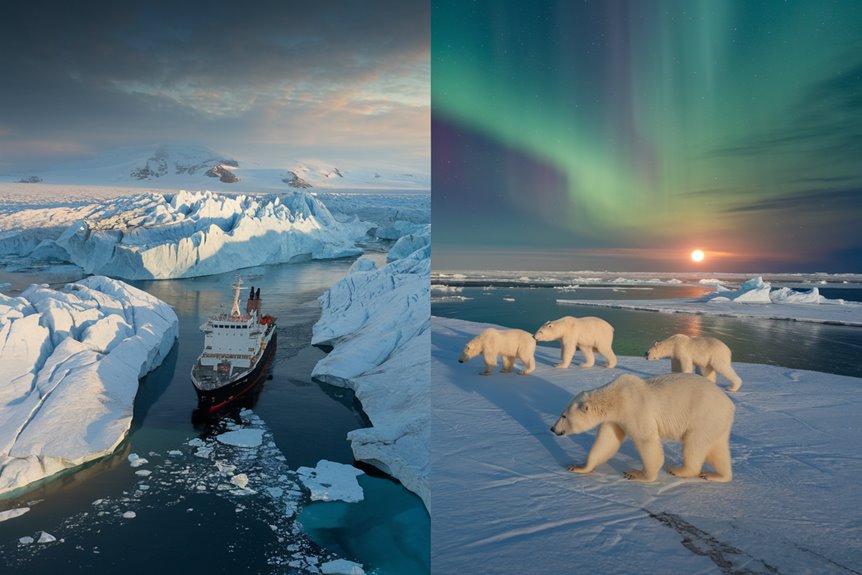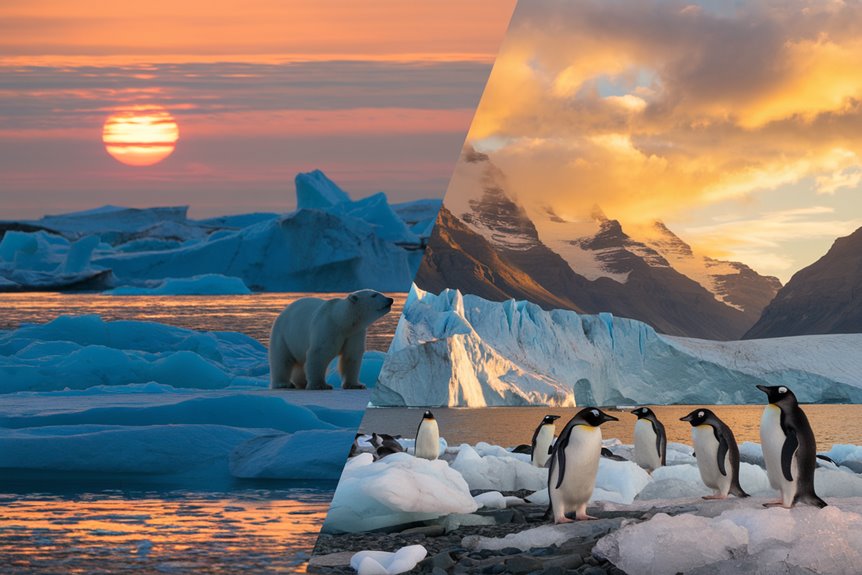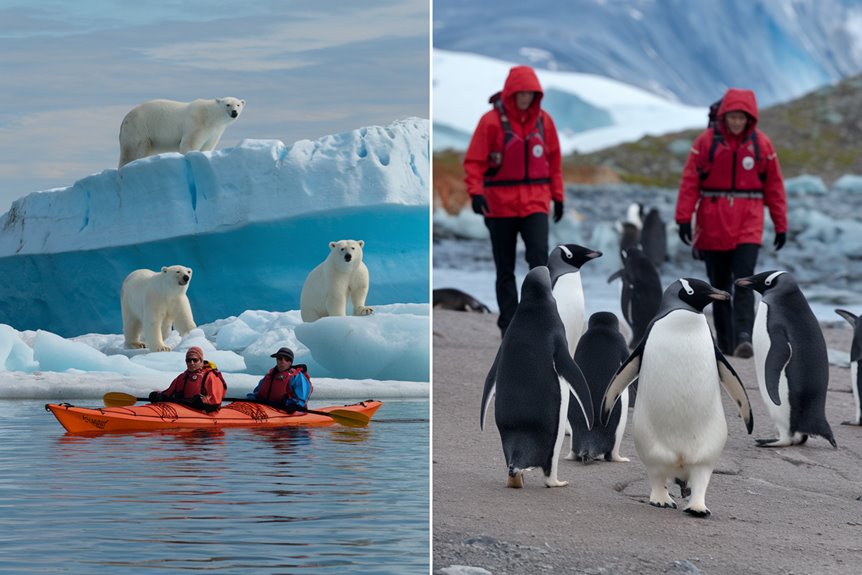You’ll find two completely different worlds when cruising to the polar regions. Up in the Arctic, you’ll see a real mix of landscapes – think fjords, mountains and summer flowers blooming away, plus polar bears, arctic foxes and walruses going about their business.
For other Polar Cruise destinations check out our Introduction to Polar Expedition Cruises Guide page.
Down in Antarctica, it’s all about massive ice sheets and giant icebergs, where penguins waddle about and seals laze around. Both places use special expedition ships with zodiacs and kayaks for getting onto land.
If you fancy the Arctic, go in June-July when it’s a bit warmer, whilst Antarctic trips run during the Southern Hemisphere’s summer months. The two poles are brilliant in their own ways – each has its own special wildlife, views and seasonal changes that make them worth a visit.
🐧 Polar Cruise Enquiry 🐻❄️
Our team of polar travel specialists have personally explored both the Arctic and Antarctic regions – from tracking polar bears in Svalbard to kayaking with penguins off the Antarctic Peninsula. Let us find the right polar expedition cruise for you.
Key Takeaways
- Arctic trips let you spot polar bears and arctic foxes roaming about, while down in Antarctica you’ll see lots of penguins waddling around and southern seals lounging on the ice.
- Antarctica’s got these massive icebergs and endless sheets of ice, but the Arctic mixes it up with mountains, fjords and bits of greenery in summer.
- If you fancy seeing the Northern Lights, head to the Arctic between August and November – that’s not something you’ll catch in Antarctica.
- The seas around Antarctica are quite choppy, so you’ll need to sail on tougher ships. Arctic waters tend to be calmer, especially when you’re cruising through the fjords.
- Up in the Arctic, you can meet local indigenous peoples and learn about their way of life, whilst Antarctic journeys are all about the raw wilderness and watching wildlife.
Wildlife Encounters in Polar Waters

The Arctic and Antarctic give you two completely different chances to see incredible wildlife.
Up in the Arctic, you’ll catch sight of huge polar bears as they hunt on ice floes, while cheeky arctic foxes scamper about the tundra.
You’ll spot walruses and different types of seals lazing about on beaches, whilst whales, including orcas and belugas, pop up near your boat.
Down in the Antarctic, it’s an entirely different bunch.
You’ll find yourself amongst groups of Emperor, Adélie, and Gentoo penguins as they wobble across spotless beaches.
Southern Elephant Seals and loads of Crabeater Seals have a kip on ice sheets, while Leopard Seals swim about looking for their next meal.
The waters are packed with humpback whales and orcas, and you can watch Wandering Albatrosses glide through the air above Antarctica’s untouched wilderness.
Expedition Ships and Navigation

Getting close to these incredible polar animals means travelling on special ships built for harsh conditions. Several craft are great for polar journeys – you’ll spot everything from posh expedition vessels like L’Austral to tough ice-strengthened ships like Ortelius and Plancius.
The toughest ships around, such as Hondius and Janssonius, have Polar Class 6 certification – the strongest ice rating for non-military vessels. They come with strengthened hulls and clever navigation kit to move safely through ice-filled seas.
These ships move at 6.5 to 15 knots, depending on which one you’re aboard, and their shallow bottoms let them slip into narrow waterways and far-flung spots. Most carry zodiacs and kayaks for going ashore, and some even have helicopters to help you see more of the polar regions.
Seasonal Highlights and Weather

Want to make the most of your Arctic cruise? Timing is key for the best wildlife and weather. The warmest period falls between June and July, when temperatures swing from -2°C to +12°C – brilliant for outdoor pursuits and watching wildlife.
See what’s on offer from the Historic Polar Cruise Routes for a different Polar Cruise destination.
Here’s a comparison between the Arctic and Antarctic regions for expedition cruises:
| Aspect | Arctic | Antarctic |
|---|---|---|
| Geography | Ocean surrounded by continents; includes parts of Canada, Greenland, Russia, Norway, and the U.S. | Continent surrounded by ocean; no countries, governed by the Antarctic Treaty. |
| Wildlife | Home to polar bears, Arctic foxes, walruses, and various whale species. | Inhabited by penguins (e.g., Adélie, emperor), seals, and whales. |
| Human Presence | Indigenous communities like the Inuit; various settlements. | No permanent residents; temporary scientific research stations. |
| Climate | Milder temperatures; experiences midnight sun in summer and polar night in winter. | Colder temperatures; summer offers continuous daylight, while winter brings extended darkness. |
| Accessibility | Accessible via multiple countries; varied departure points. | Typically accessed from South America, mainly Ushuaia, Argentina. |
| Activities | Opportunities for cultural interactions, wildlife viewing, and exploring diverse landscapes. | Focus on pristine landscapes, ice formations, and unique wildlife encounters. |
Shore Excursions and Activities

The incredible Arctic views from the ship are just the beginning – it’s when you step onto land that your polar trip really comes alive.
Here’s a comparison of activities available during Arctic and Antarctic expedition cruises:
| Activity | Arctic | Antarctic |
|---|---|---|
| Wildlife Viewing | Spot polar bears, Arctic foxes, walruses, reindeer, and various whale species. | Observe penguins (e.g., Adélie, emperor), seals, and whales. |
| Cultural Experiences | Visit Indigenous communities like the Inuit; explore traditional villages and museums. | No permanent residents; focus on historical sites of early explorers. |
| Hiking | Trek through varied landscapes, including tundra and coastal areas. | Landings often revolve around visiting and photographing penguin rookeries. |
| Kayaking | Paddle through fjords and alongside icebergs; commonly available. | Navigate among icebergs and glaciers; offered on select voyages. |
| Dog Sledding | Experience traditional dog sledding, sometimes on wheels during summer. | Not typically available. |
| Camping | Rarely offered. | Overnight camping on ice available on select itineraries. |
| Polar Plunge | Opportunity to jump into freezing Arctic waters. | Chance to dive into icy Antarctic waters. |
| Snowshoeing/Skiing | Available in certain areas; depends on itinerary. | Offered on specialized voyages; less common. |
Landscape and Scenery Comparisons

The Arctic and Antarctic look completely different, giving you two distinct types of polar travel. Antarctica is a pure, white continent full of ice and snow with enormous flat-topped icebergs, whilst the Arctic shows off different sorts of landscapes – you’ll see mountains, fjords and colourful wildflowers in summer.
Antarctica tends to be more consistently striking, with its massive ice sheet spanning more than 14 million square kilometres, but the Arctic’s look changes with the seasons.
- Antarctica’s scenery includes soaring ice cliffs, stark polar deserts, and a pair of active volcanoes near the Ross Sea.
- The Arctic has clear, deep fjords, green summer slopes, and you might catch sight of the Northern Lights.
- Antarctica’s icebergs are usually bigger and more imposing, whilst the Arctic has more varied ground you can actually walk on.
Frequently Asked Questions
What Medical Facilities Are Available on Arctic Expedition Ships?
The ships have proper medical centres with doctors on call day and night – a bit like a mini hospital at sea. You’ll find standard medical kit including defibrillators and common medicines. There’s also special rooms to keep people separate if they have something contagious.
Can I Use My Regular Mobile Phone Service During Arctic Cruises?
Your mobile reception gets spotty during Arctic cruises. When docked at ports, your mobile will work as usual, but you’ll pay roaming fees. Once you’re out at sea, it’s best to stick with the ship’s Wi-Fi to stay connected.
How Much Luggage Can I Bring on an Arctic Expedition Cruise?
Your limit for the trip is 20kg in total: 15kg for your main bag and 5kg for your carry-on. It’s best to bring soft bags rather than hard suitcases. Have a look at your booking details though, as some expeditions let you bring up to 50 pounds.
Are Arctic Cruises Suitable for Passengers With Mobility Limitations?
Arctic cruises are doable if you have mobility issues – the ships have wheelchair-friendly cabins and lifts. Just keep in mind you might struggle with getting in and out of the small Zodiac boats and walking on shore. Best to have a chat with the cruise company about your requirements before you book.
What Currencies Are Accepted Onboard and at Arctic Ports of Call?
You’ll want to keep USD handy when sailing with Swan Hellenic and Holland America, whilst Oceanwide prefers Euros. When you pop into ports, make sure you’ve got the right local money: Norwegian Kroner, Canadian Dollar, Danish Krone, or Euros.
Thinking about something different? Check out the Polar Cruise Environmental Impact.
🐧 Polar Cruise Enquiry 🐻❄️
Our team of polar travel specialists have personally explored both the Arctic and Antarctic regions – from tracking polar bears in Svalbard to kayaking with penguins off the Antarctic Peninsula. Let us find the right polar expedition cruise for you.
